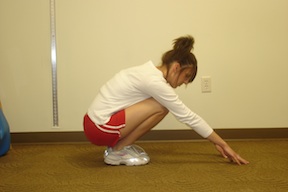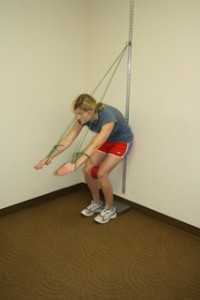Here’s the good news about cycling: It has significantly less weight bearing and impact load than it’s more popular aerobic counterpart, running. Meaning, it’s easier on your body. Here’s the bad news: Cycling injuries are not that much less prevalent than those seen in running. Aside from crashes, cycling injuries tend to be overuse in nature, and are based more on how a rider’s body functions in relation to their bike—i.e. a rider’s biomechanics.
By making a series of small tweaks to the geometry of the bike, professional bike fitters can do amazing things to make a rider comfortable. Fitters, based on their methodology and level of expertise, will take many factors into consideration when ultimately settling on a fit for their client. These factors include (but are definitely not limited to) seat height and fore-aft position, handle bar and brake lever/shifter position, pedal type, and cleat position. Unfortunately a proper discussion about bike fitting would be far too extensive for this article, but one must consider it an absolutely vital role in meshing the asymmetrical human body to the symmetrical bicycle. Undoubtedly, a good bike fit is worth every penny a cyclist spends on one.
For the orthopedic physical therapist treating a cyclist (that’s me), the key to treating injuries is in understanding the inherent asymmetry of the body. When specific joint and soft tissue dysfunctions are present, poor postural patterns can result on the bike, leading to habitual tendencies—and pain. The key to treating these tendencies is in examining the cyclist, and understanding how they compensate for poor biomechanics on the bike. A cyclist’s tendency to compensate for biomechanical misalignment is intensified when the cyclist (or any athlete) encounters a greater workload, higher respiratory demands, and ultimately, fatigue. The following is a discussion of common spine injuries that cyclists sustain.
Low Back Pain
Cyclists encounter low back pain on the bike when their position demands greater extension (arching) or flexion (rounding) of their spine than their soft tissues or joints are capable of. Most often I find that cyclists with back pain are set up in a position that 1) excessively spreads them out from their hand position to their hip position on the saddle; 2) excessively lengthens their hip position to their foot position; 3) or both. These situations will cause their pelvis to tilt forward too much, arching their back.
In the situation of too long of a reach, the resultant rib cage position causes even more problems. As the arms reach too far forward the lower front ribs will flare out. This disengages the core abdominal muscles and changes breathing mechanics to where the cyclist will use their lower back muscles more than those muscles can tolerate for sustained periods. When the back muscles become tonic and overdeveloped the pelvis begins to tilt forward even more, and over time compressive issues such as disc herniation and nerve irritation start to occur.
A cyclist’s lower back rounds (or flexes) too much when their position from hands to hips, or hips to feet, is too compact. This causes the pelvis to tilt back too far or, in the case of not having a long enough reach to the pedals, forces the hips to flex beyond their range of motion capabilities. Cyclists need to be able to flex their hips a minimum of 115 degrees. If that isn’t possible then the pelvis will be forced to rock back while seated on the bike (hyper-flexing the low back), especially when the hands are in the drops. In this situation the hips (femur bone) will also be forced to compensate by rotating outward causing the pelvis to rock or spin on the saddle. Now the whole lower leg is out of alignment, opening up the cyclist to other lower extremity issues.
We will often find the problem occurring on one side and not the other. This is because the body is not symmetrical. Some of our most important organs are predominantly located on one side of our body (heart, liver) and our diaphragm and lungs are shaped differently on either side. This sets us up to position ourselves, move, and function in slightly (and sometimes very) asymmetrical ways. The diaphragm and lungs are of particular importance as there is often an asymmetrical look to the rib cage and a slight, but significant, difference in respiratory mechanics on one side of the body compared to the other. There is a school of thought that this is the root of a lot of the problems seen in cycling. The cyclist is basically fixed into position at the feet and the hands, so if they can’t control the asymmetrical tendencies of their body (i.e. breathing) then they will compensate and eventually have problems.
Neck Pain
Neck and shoulder strain is usually caused by a problem with the cyclist’s position on the front end of the bike. Having to reach too far for the handlebar hoods or too low for the handlebar drops may put the neck and upper back soft tissues and joints at or near their limits. This usually causes strain on both sides of the neck/shoulder junction or centrally in the middle part of the neck. But, again, if the cyclist is sitting with poor hip alignment then they will be have to reach their arms differently and position their head and shoulder girdle asymmetrically.
I have found that asymmetrical breathing patterns, caused by or in conjunction with an asymmetrically positioned pelvis, are the most common finding with cyclists. Again, there are very common patterns, and my example here is one of them. Let’s say a cyclist has more difficulty breathing into their right chest wall. Their posture may compress the rib cage on that side so that it’s hard for the ribs to expand for greater air intake. They may make several compensations. One of them may be to recruit their neck muscles to help pull air in. Some of these muscles have a direct attachment to the first few ribs and sternum and can be used excessively to move these ribs to expand the chest, especially under increased cardiovascular demands. The result is neck pain, over-activity and tightness, and a potential cascade of cervical spine problems.
These are just a few examples of spine issues we find in cyclists. The bottom line is that there are asymmetrical postural tendencies in the human body. Most people can control them with good awareness, strong core muscles, and healthy soft tissues. A good bike fit can also correct some of these postural influences. But, if problems persist, the cyclist may need to visit a good orthopedic physical therapist or chiropractor to evaluate and sort out their twisted body.


